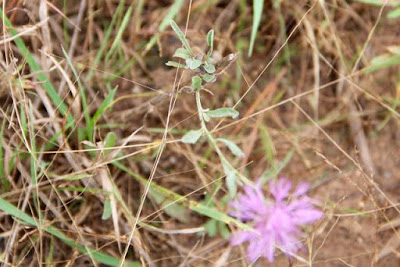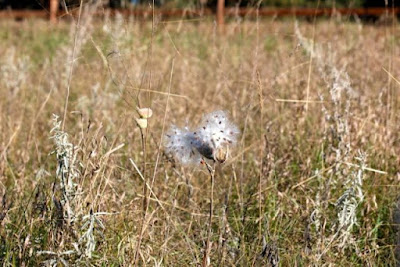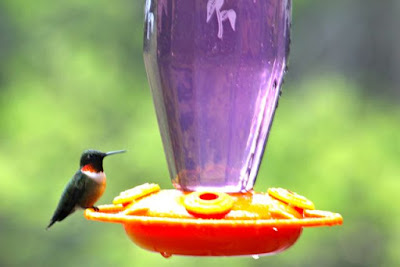How much is a bee worth? How much do you care? How do you feel about risk management? I'm thinking about those questions because of a frustrating morning trying to buy some "safe" chrysanthemums. I've become more and more sensitive to the issue of killing off our pollinators, since I like to eat. My first stop was at a "big box" grocery store with lots of colorful mums and some pumpkins for sale at the entrance. I went inside and asked an employee whether the mums were "neonicotinoid free." The short version of the answer I got is probably but maybe not legally. If the supplier grew them, yes. If grown by a third (fourth?) party through the supplier probably, but possibly not. It's not clear if this is a communications, supply chain management issue or both. I didn't buy the explanation or the mums.
 |
Mums the word come Autumn
|
Down the road is a big box home supply store with, of course, a garden center. The first employee didn't know the answer to my question, put in a call on the store's communication system, didn't get a response and suggested I check with "customer service" in the store. After waiting five minutes or so for the person at the counter to be attended to, I asked about the mums and neonicotinoids. Suddenly, I was looked at as if I'd grown an extra eye in the middle of my forehead. "We buy these from suppliers. I have no idea of the answer. No one's ever asked about this before."
Strike two in my effort to save a buck or two on fall plantings. I don't want to add to the local pesticide loads our pollinators have to deal with. At home I checked on line to see what's available at a local nursery-garden store we often shop at. Checked pdfs of price lists and plant lists etc. NO CHRYSTHANTHEMUMS!? I have no idea why but may ask the next time I'm in their neighborhood.
Still on-line, I tried a large Twin Cities floral-garden company's web site. They have mums. They're also know to be committed to avoiding pollinator poisons in their plants. PROGRESS! The mums they have are 50% to 100% more than the first stop, the local grocery store. If I buy six plants, the total different in price will be about the same as the cost of a tank of gas, but the plants will be somewhat larger, so let's say half a tank of gas. Ever since I got out of high school, I've not let gas expenses affect my travels. For a good night's sleep and a clear conscience, it's cheap at twice the price. I'll be buying our plants at the place know to be sensitive about avoiding neonicotinoids.
My frustration is ameliorated somewhat by hoping that I may have made a very minor impact on some big box employees, who may mention it to management, who may get communications and supply chain changes going. When was the last time you worried about
Alar in your apple juice? Our consumer-capitalist system is damned insensitive and believes that everything is a commodity and that we consumers don't care about anything but price. It's up to us to educate them. Do I think you should ask about pesticides, whether or not you intend to buy plants? Absolutely! Washington's football team's name is still a racist slur, isn't it? We consumers need to rise to the challenge of helping create the world we want in each of our four seasons. Interestingly enough, employees at the same places that failed today were more aware of the pesticide concerns last Spring when we were shopping for Spring planting.
Happiness
I have been taught never to brag but now
I cannot help it: I keep
a beautiful garden, all abundance,
indiscriminate, pulling itself
from the stubborn earth: does it offend you
to watch me working in it,
touching my hands to the greening tips or
tearing the yellow stalks back, so wild
the living and the dead both
snap off in my hands?
The neighbor with his stuttering
fingers, the neighbor with his broken
love: each comes up my drive
to receive his pitying,
accustomed consolations, watches me
work in silence awhile, rises in anger,
walks back. Does it offend them to watch me
not mourning with them but working
fitfully, fruitlessly, working
the way the bees work, which is to say
by instinct alone, which looks like pleasure?
I can stand for hours among the sweet
narcissus, silent as a point of bone.
I can wait longer than sadness. I can wait longer
than your grief. It is such a small thing
to be proud of, a garden. Today
there were scrub jays, quail,
a woodpecker knocking at the white-
and-black shapes of trees, and someone’s lost rabbit
scratching under the barberry: is it
indiscriminate? Should it shrink back, wither,
and expurgate? Should I, too, not be loved?
It is only a little time, a little space.
Why not watch the grasses take up their colors in a rush
like a stream of kerosene being lit?
If I could not have made this garden beautiful
I wouldn’t understand your suffering,
nor care for each the same, inflamed way.
I would have to stay only like the bees,
beyond consciousness, beyond
self-reproach, fingers dug down hard
into stone, and growing nothing.
There is no end to ego,
with its museum of disappointments.
I want to take my neighbors into the garden
and show them: Here is consolation.
Here is your pity. Look how much seed it drops
around the sparrows as they fight.
It lives alongside their misery.
It glows each evening with a violent light.
********************************************
Thanks for visiting. Come again when you can.
Please be
kind
to each other while you can.


























